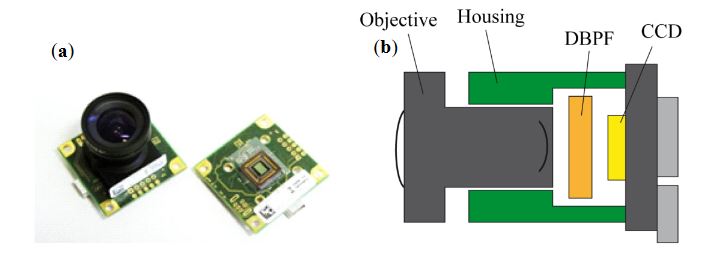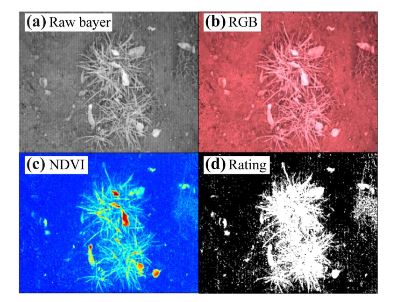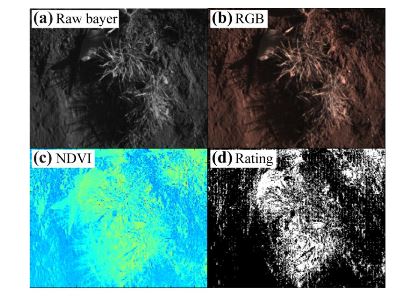ABSTRACT
The application of (smart) cameras for process control, mapping, and advanced imaging in agriculture has become an element of precision farming that facilitates the conservation of fertilizer, pesticides, and machine time. This technique addition ally reduces the amount of energy required in terms of fuel. Although research activities have increased in this field, high camera prices reflect low adaptation to applications in all fields of agriculture.
Smart, low-cost cameras adapted for agricultural applications can overcome this drawback. The normalized difference vegetation index (NDVI) for each image pixel is an applicable algorithm to discriminate plant information from the soil background enabled by a large difference in the reflectance between the near infrared (NIR) and the red channel optical frequency band. Two aligned charge coupled device (CCD) chips for the red and NIR channel are typically used, but they are expensive because of the precise optical alignment required.
Therefore, much attention has been given to the development of alternative camera designs. In this study, the advantage of a smart one-chip camera design with NDVI image performance is demonstrated in terms of low cost and simplified design. The required assembly and pixel modifications are described, and new algorithms for establishing an enhanced NDVI image quality for data processing are discussed.
MATERIALS AND METHODS

Figure 1. Reflectance s pectral response from Arabidopsis (green) and organic garden soil (brown) (measured July 2010)
The NDVI facilitates the discrimination of plant from soil pixels in a digital camera and can be used in a quantitative manner to obtain information concerning the chlorophyll activity in the plant. This can be used for further analysis and cannot be performed simply using the green channel of an RGB camera. The NDVI works because of the high absorption in the red band by chlorophyll molecules and the increased reflection in the NIR band. Figure 1 shows the difference between a typical soil spectrum and the plant spectrum.

Figure 4. (a) The spectral response of the MT9V032STC CMOS image sensor from the IDS datasheet
This single RGB chip has an asymmetric color pattern. The green pixels are represented twofold more than the red and blue pixels (Figure 4(b)). Therefore, the “green” precision is better, with respect to the increased sensitivity of the human eye for green color. The automatic gain control of the camera varies the output levels of the color bands, but often and in our case, this feature is optimized for the green channel and not for the red.
RESULTS AND DISCUSSION

Figure 9. (a) Raw image of tufts of grass and leafs added by wind

Figure 10. (a) Raw image of tufts of grass and leafs added by wind
Demonstrating the usability of the single chip plant camera small sets of images under different lighting conditions and with different plants were taken. The results shown below in Figures 9 and 10 illustrate the difficulties of the single-chip plant camera. These results demonstrate the need for an adapted NDVI algorithm to establish a useful plant camera.
CONCLUSIONS
The results demonstrate that a plant detection camera was designed with a new arrangement of the optical filter design to obtain a low-cost digital image sensor. This filter disables the blue and green color sensitivity and enables the true path of NIR light in the 850 nm regime. Therefore, the blue and green pixels can be used for new, pure NIR channels. The contrast in the NDVI image could be optimized with a more specific optical filter.
Where as a simple low-pass filter is working; a double band pass filter for the transmission of the red band, from 620 nm to 660 nm, and the NIR band, from 780 to 900 nm removes the intensities between the two transmission bands. This results in an elimination of the transient region of the NIR sensitivity of the different camera channels, and therefore the output response is better defined.
The use of the raw Bayer image of the CCD chip reduces the number of pixels; therefore, the data bus to the processing unit was not overloaded with large RGB arrays, which would occur with a tiff format. The user can decide whether the data reduction is important for implementing the algorithm in an embedded system with restricted memory and processor power resources, or whether a debayering algorithm is needed for pixel filling.
Either strategy will be used equally, and the algorithm derived from the camera must be disabled because it is optimized for natural RGB images and is useless for the NDVI image. This is also true for green color optimized automatic gain control functions because the new “red” channel is the most dominating, with summedred and NIR intensities. Thus, full pixel control is indispensible for a single-chip plant camera.
Whereas the NDVI is a well-known and frequently used index for gathering the information content of plants, the direct application of a low-cost, single-chip plant camera is difficult under real outdoor conditions. Therefore, a simple threshold for detecting, for example, the coverage level is not sufficient.
Even under the best lighting conditions, that is, stray light, the NDVI requires some enhancement to reach sufficient performance or precision for coverage level. For the eNDVI, we demonstrated that multiplication using the averages of both NIR channels generates a successful rating for plant soil separation. However, an even better algorithm is required under the worst illumination conditions with angular sunlight.
Source: University of Arkansas
Authors: Volker Dworak | Joern Selbeck | Karl-Heinz Dammer | Matthias Hoffmann | Ali Akbar Zarezadeh | Christophe Bobda